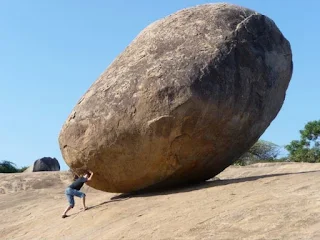Krishna's Butterball (also known as Vaan Irai Kal and Krishna's Gigantic Butterball) is a gigantic granite boulder resting on a short incline in the historical town of Mahabalipuram in India. The boulder is approximately 6 meters high and 5 meters wide and weighs around 250 tons. It stands on an approximately 1.2-meter (4 ft) base on a slope, and is said to have been at the same place for 1200 years.
In 1908, then-governor of the city Arthur Havelock made an attempt to use seven elephants to move the boulder from its position due to safety concerns, but with no success. It is said that Pallava king Narasimhavarman too made a failed attempt to move the boulder. The original name, a tamil word Vaan Irai Kal, according to the Atlas Obscure, translates to "Stone of Sky God". According to Hindu mythology, lord Krishna often stole butter from his mother's butter handi; this may have led to the namesake of the boulder. In 1969, a tour-guide is said to credit its present name, Krishna's Butterball, to Indira Gandhi who was on a tour of the city. A part of the boulder has eroded away, making it look like a half-spherical rock. It is said that the South Indian Tamil king Raja Raja Chola was inspired by the balance of this massive stone boulder and it led to the creation of never falling mud dolls called Tanjavur Bommai, which having a half-spherical base tends to come back to its original position every time one tries to make it fall. The boulder is bigger and heavier than the monolithic stones of Ollantaytambo and Machu Picchu of Peru. It is a popular tourist attraction in the city and is listed as a historical monument by the Archeological Survey of India
The rock’s position is quite astonishing as it looks like it’s about to roll down the slope. However, it stands firm and tourists can even take shade under it. It is estimated to weigh over 250 tons! A part of the rock is sheared off, making it look like a half circle. The reason for the erosion is still unknown. Krishna's Butter ball challenges modern technology today, as it fails to answer an important question - how does a 250-ton rock stand on a less-than-4-feet base?









No comments:
Post a Comment
Stay updated with our blog for more quality content! Your feedback is appreciated. Contact us at harshrex@outlook.com with any suggestions.